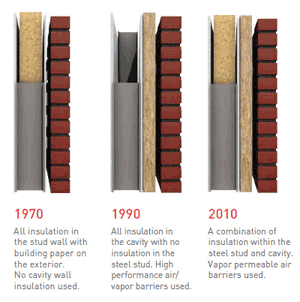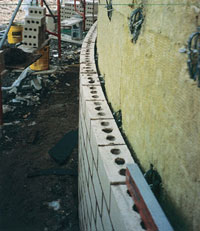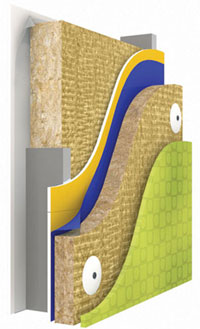Stone Wool Insulation - Improving Building Performance
 |
The progression of thought on cavity wall insulation over the past forty years. Image courtesy of Roxul Inc. |
Cavity Walls
The primary functions of a cavity wall system have not changed fundamentally over the past 40 years, namely to protect against unwanted heat transfer, air infiltration, rain penetration, movement of moisture, and fire. Further the desirable aspects of durability, noise and light control, strength, and aesthetics all have remained fairly constant needs. The same cannot be said for the components and design of cavity wall systems, which have undergone a significant transformation in North America. This change in design requirements is a result of the increased focus on ASHRAE standards and the need for continuous insulation to meet the R-value and U-value requirements of ASHRAE 90.1. The traditional approach has been for batt type insulation to be placed between the framing members. This had the benefit of economizing on wall thickness, but did not provide continuous insulation across the wall due to the recurring thermal bridging of the studs. The insulation would also be routinely compromised by mechanical, plumbing, or electrical components embedded within the same stud cavity. A second approach of using only continuous board type insulation outside of the studs overcame the continuous insulation issue, but the thicknesses were sometimes compromised due to increasing costs related to increasing wall thicknesses. A current approach is to combine the two, using continuous board type insulation outside of the stud and batt type between the studs with attention to detail in all cases to avoid compromise and thermal bridging.
There are stone wool insulation products that are designed specifically for exterior wall steel and wood stud applications. The properties of this insulation include batts that compress or expand between frame studs or joists to completely fill the cavities. R-values are available in batts rated at R10, R14 (Canada), R15 (USA), R22.5 and R24 depending on thickness. The water and moisture resistant properties of the material means that it repels water to protect walls and studs. It will not rot, promote mildew, fungi, or bacteria, or sustain vermin. Finally, it is easy to handle on the jobsite since it is easy to cut with a serrated knife similar to other batt type insulation.
 |
Rigid stone wool insulation conforms to curves and wall irregularities. Image courtesy of Roxul Inc. |
Not to be overlooked is the sag resistant capability and higher density of stone wool which allows for tighter fits that don't lose their shape inside cavities. These attractive properties impede natural convection currents in the stud cavities which can greatly reduce the thermal insulation's effectiveness and in some instances completely negate the thermal value. It is important to detail the insulation as filling the cavity space completely in this regard. Using stone wool that is flexible and can conform to curves and wall irregularities reduces convection. Rigid thermal insulations cannot conform to such wall irregularities and architectural curves, therefore increasing the potential for natural convection behind the thermal barrier. It should also be noted that stone wool is up to four times denser than fiberglass insulation which does not have the same ability to impede convection currents and air flow in cavities. Hence to eliminate the potential for natural convection behind thermal insulation the use of full depth, flexible and conforming, dense stone wool insulation is highly recommended.
 |
Stone wool batt insulation in the steel stud & stone wool continuous insulation in the exterior cavity Image courtesy of Roxul Inc. |
Continuous Insulation and Rainscreen Walls
Stone wool insulation board is quite suitable as a non-combustible, water repellent sheathing when engineered for both cavity wall and rainscreen applications. As a continuous insulation, it provides excellent thermal performance and minimizes thermal bridging otherwise caused by stud assemblies. Typical products are manufactured in a mono density format that deliver an R-value/inch of 4.2 and is generally available in thicknesses of up to 2 inches. For assemblies requiring higher R-values, dual density products deliver an R-value of 4.3/inch in thicknesses of 2.5 to 5 inches. This mixed density insulation combines a high density outer layer and a more compliant, low density inner layer that are created simultaneously during the manufacturing process.
Properties to look for in this application include the non-combustibility of the stone wool insulation, water and moisture resistance to avoid moisture absorption, long term insulating value, and freedom from rot, mold, mildew, fungi, bacteria, or vermin. Further, since this product is field installed, stone wool is simple to cut with a serrated knife for clean straight edges and fits properly at the point of installation. Quick and easy cutting means less waste and faster installation, which saves money on labor and lost production time.
When used in a rainscreen application, it is worth noting that proper attention to detail and construction are important for creating an effective envelope solution to external moisture penetration. In general, the purpose of the "rainscreen" is to limit the amount of water entering the building's exterior envelope. The rainscreen principle can be divided into 3 basic components, the rainscreen, the air space and the drainage layer. The rainscreen's function is to screen the driving rain and limit the potential for moisture entering the wall system. The air space including weep holes/opened joints will allow for the equal pressurization of the rainscreen. By introducing equal pressurization within the wall system the air pressure differential will theoretically be equal, essentially eliminating the suction of water into the open cavity. The drainage plane's function is to direct the minimal amount of water that enters the cavity to the exterior by the use of flashings. The impact of penetrating moisture on thermal insulation installed in a cavity wall is minimal due to the location of the insulation, presence of airspace, types of opening and types of cladding. Stone wool insulation will support and contribute to all of these criteria.
Curtain WallsIn curtain walls, a lightweight semi-rigid stone wool insulation board is most appropriate particularly when it is specifically designed for backpan or mechanical fastening applications. Generally such products are available in 24" x 48" and 24" x 60" panels while some also come in larger 36" x 48", and 48" x 72" panels. The properties to specify in this case include a low moisture absorption rate which effectively drains water away from exterior walls, higher R-values for lasting thermal protection, and non-combustibility product for safety including approval for use as a component of UL-approved systems. To help with general human health and comfort issues, the insulation board should also be sound absorbent, chemically inert, non-corrosive, and not rot, promote the growth of mildew, fungi, or bacteria. Finally, fabrication with reinforced foil facings is often desirable for installation and maintenance reasons.









